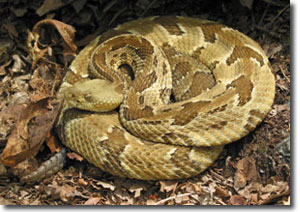Adaptations
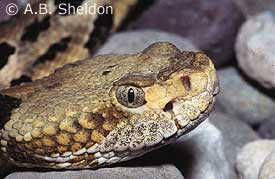 Overall,
timber rattlesnakes have evolved and adapted to their environment profoundly
well. For example, they contain many sensory organs that allow them to
detect the presence of other organisms in the area. Some of these sensory
organs include two facial pits located on either side of the head that
detect body heat, a thin tongue that can absorb chemicals and molecules in
the air, and an organ in the mouth, called Jacobson’s organ, that can
identify these molecules to determine where and what they came from. All of
these organs have successfully enabled the rattlesnake to capture its prey
and evade predators. C. horridus also contains a pair of large,
venomous fangs that aid in food acquisition and protection in a very
efficient way. By using these deadly fangs, C. horridus can
terminate their prey and predators in a very short amount of time without
having to expend a lot of energy.
Overall,
timber rattlesnakes have evolved and adapted to their environment profoundly
well. For example, they contain many sensory organs that allow them to
detect the presence of other organisms in the area. Some of these sensory
organs include two facial pits located on either side of the head that
detect body heat, a thin tongue that can absorb chemicals and molecules in
the air, and an organ in the mouth, called Jacobson’s organ, that can
identify these molecules to determine where and what they came from. All of
these organs have successfully enabled the rattlesnake to capture its prey
and evade predators. C. horridus also contains a pair of large,
venomous fangs that aid in food acquisition and protection in a very
efficient way. By using these deadly fangs, C. horridus can
terminate their prey and predators in a very short amount of time without
having to expend a lot of energy.
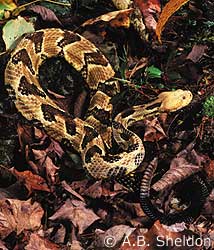 The skin of C. horridus is composed of tough, dry, overlapping
scales made of keratin that aid in retaining water. Besides keeping the
rattlesnakes hydrated, these keratinized scales are also very important in
motility. Since timber rattlesnakes do not have any limbs, they move by
slithering along the ground, instead of walking or crawling like other
animals do. The scales located on the ventral side of the rattlesnake are
much smoother and shinier than the scales found on the rest of the body and
therefore permit the rattlesnake to move swiftly and efficiently along the
substrate without much hindrance. In order to keep its skin in mint
condition, C. horridus will shed its skin one to three times a year for the
rest of its life. Another adaptation that timber rattlesnakes have is the
ability to use their skin color to blend in with their surroundings in order
to hide from predators and ambush prey.
The skin of C. horridus is composed of tough, dry, overlapping
scales made of keratin that aid in retaining water. Besides keeping the
rattlesnakes hydrated, these keratinized scales are also very important in
motility. Since timber rattlesnakes do not have any limbs, they move by
slithering along the ground, instead of walking or crawling like other
animals do. The scales located on the ventral side of the rattlesnake are
much smoother and shinier than the scales found on the rest of the body and
therefore permit the rattlesnake to move swiftly and efficiently along the
substrate without much hindrance. In order to keep its skin in mint
condition, C. horridus will shed its skin one to three times a year for the
rest of its life. Another adaptation that timber rattlesnakes have is the
ability to use their skin color to blend in with their surroundings in order
to hide from predators and ambush prey.
Timber rattlesnakes are
characterized by having dark bands or chevrons running the length of their
dorsal surface and
have been known to possess skin colors ranging from light yellow to brown,
and gray to black. In fact, C. horridus has two col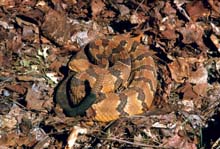 or morphs,
one being yellow, the other being black. The black morph is most prevalent
in the northern regions of the country where dark, wooded areas are
dominant. Basically, morphs are animals that bear unique patterns and
colorations within a single brood. This variation in color patterns
and shapes improves the rattlesnake's ability to blend in with its
environment. An example of this "camouflage" can be seen in the
picture to the right where the rattlesnake blends in very well with the
rust-colored leaves.
or morphs,
one being yellow, the other being black. The black morph is most prevalent
in the northern regions of the country where dark, wooded areas are
dominant. Basically, morphs are animals that bear unique patterns and
colorations within a single brood. This variation in color patterns
and shapes improves the rattlesnake's ability to blend in with its
environment. An example of this "camouflage" can be seen in the
picture to the right where the rattlesnake blends in very well with the
rust-colored leaves.
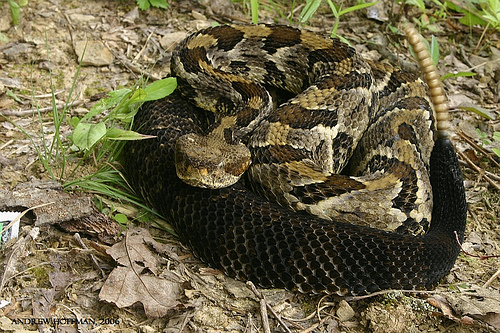
One very prominent feature that C. horridus has adapted is a black-colored rattle located at the end of its tail. These rattles, which begin as small button-like structures, are made up of many horny segments that help determine how many times an adult rattlesnake has shed its skin. Each time the skin is shed, another ring is added to the rattle, therefore, full grown rattlesnakes have much larger rattles with many more rings. The rattle is also an important defense mechanism because it warns other organisms to stay away when C. horridus is present within the area.
Back to Home Page
To learn more about the Reproduction of this organism, click
here
